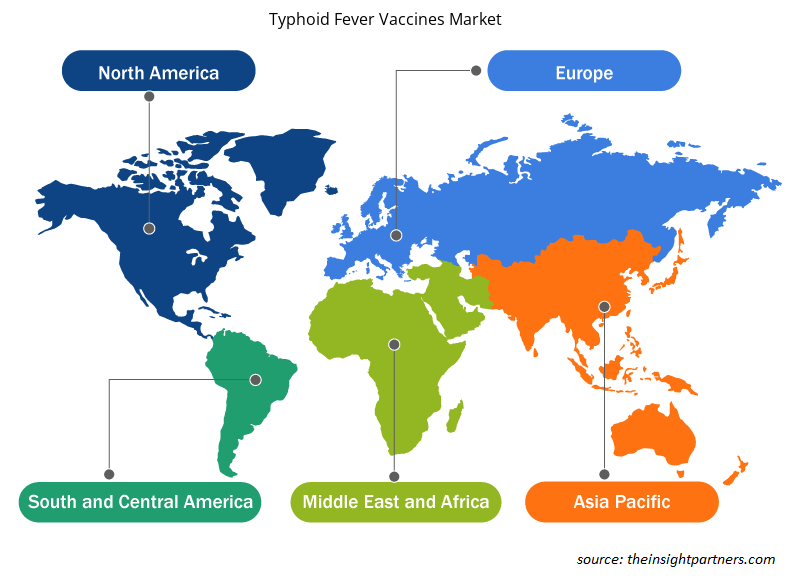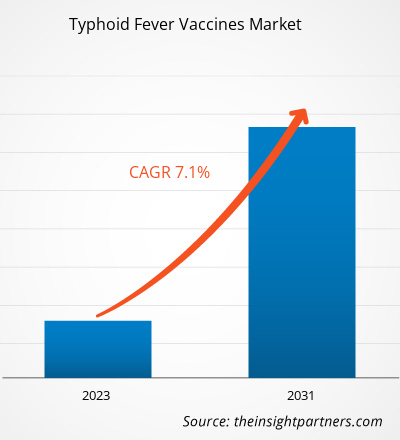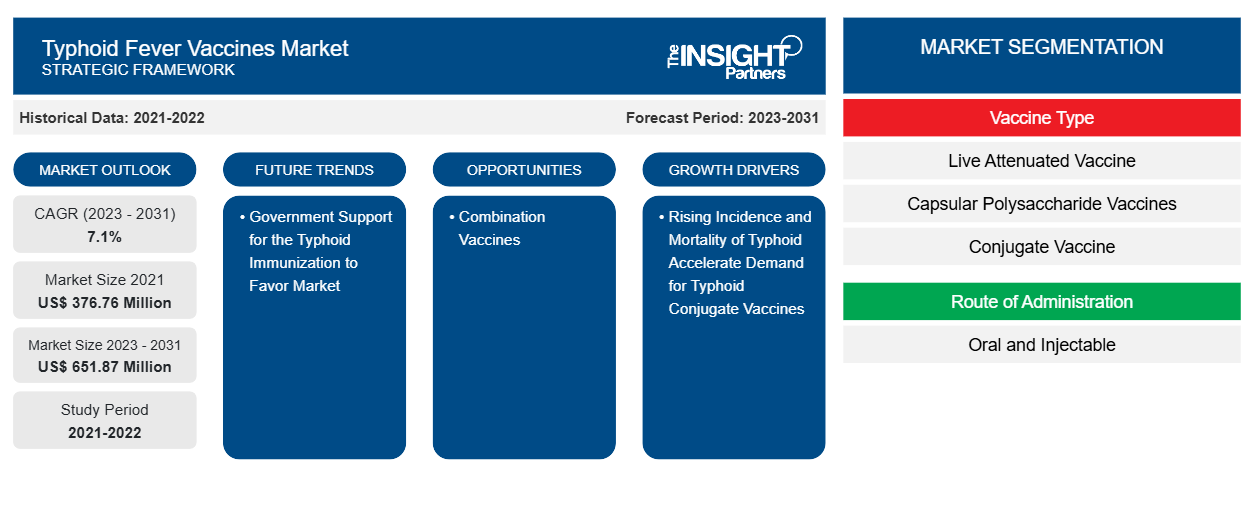Il mercato dei vaccini contro la febbre tifoide è stato valutato a 376,76 milioni di dollari nel 2021 e si prevede che raggiungerà i 651,87 milioni di dollari entro il 2031. Si prevede che il mercato registrerà un CAGR del 7,1% dal 2023 al 2031. È probabile che la penetrazione dei vaccini combinati contro la febbre tifoide rimanga una delle tendenze chiave del mercato dei vaccini contro la febbre tifoide.VaccinesMarket was valued at US$ 376.76 million in 2021 and is expected to reach US$ 651.87 million by 2031. The market is expected to register a CAGR of 7.1% from 2023–2031. Penetration of combination typhoid vaccines is likely to remain key Typhoid Fever Vaccines Market trends.
Analisi di mercato dei vaccini contro la febbre tifoide
L'aumento dell'incidenza e della mortalità del tifo accelera la domanda di vaccini coniugati contro il tifo
Secondo il rapporto di marzo 2023 dell'Organizzazione Mondiale della Sanità (OMS), nel 2019 circa 9 milioni di persone si sono ammalate di febbre tifoide e 110.000 persone muoiono ogni anno a causa della febbre tifoide. Inoltre, i viaggiatori sono ad alto rischio di sviluppare la febbre tifoide, in particolare in Asia e nell'Africa subsahariana. Pertanto, con l'aumento dei casi di incidenza e mortalità, la domanda di vaccini contro il tifo è al massimo storico. Ad esempio, l'OMS consiglia ai paesi di adottare l'immunizzazione tramite vaccini coniugati contro il tifo (TCV) per controllare la malattia nelle regioni endemiche. Il TCV è il primo vaccino contro il tifo adatto ai bambini a partire dai sei mesi di età ed è la scelta di vaccino contro il tifo più preferita a livello globale. Il Global Vaccine Market Model (GVMM) ha stimato che i ricavi totali del mercato del TCV nei paesi a medio reddito (MIC) e nei paesi a basso reddito (LIC) raggiungeranno i 44 milioni di dollari USA, rappresentando solo una quota di mercato di circa il 14%. travellers are at high risk of developing typhoid fever, particularly in Asia and Sub-Saharan Africa. Therefore, with rising incidence and mortality cases, demand for typhoid vaccines is all-time high. For example, the WHO advises countries to adopt immunization by Typhoid Conjugate Vaccines (TCV) to control the disease in endemic regions. The TCV is the first typhoid vaccine suitable for children from six months of age and is the most preferred typhoid vaccine choice globally. The Global Vaccine Market Model (GVMM) estimated that the total market revenues for TCV in middle-income countries (MICs) and Low-Income Countries (LICs) are estimated to reach US$ 44 million, only representing a market share of approx—14%.
Fonte: GVMM
Inoltre, il Fondo delle Nazioni Unite per l'infanzia (UNICEF) detiene una quota di mercato del vaccino TCV superiore al 95%, in particolare nell'Africa subsahariana e nell'Asia meridionale e sudorientale per i LIC e i MIC. L'adeguata fornitura di vaccini TCV nell'Africa subsahariana e nell'Asia meridionale e sudorientale è effettuata dall'UNICEF per ridurre i casi di febbre tifoide ad alto tasso tra la popolazione. Pertanto, l'aumento della prevalenza e della mortalità associate alla febbre tifoide, la corretta domanda e fornitura di vaccini contro il tifo nei paesi epidemici sono i fattori influenti responsabili della crescita del mercato dei vaccini contro la febbre tifoide nel periodo 2021-2031.
Panoramica del mercato dei vaccini contro la febbre tifoide
L'intervento del governo e le soluzioni intelligenti per la somministrazione dei vaccini continuano a influenzare significativamente i vaccini contro la febbre tifoide. Il sostegno del governo all'immunizzazione contro il tifo e l'aumento dell'incidenza e della mortalità del tifo sono i fattori più influenti responsabili della crescita del mercato dei vaccini contro la febbre tifoide. I vaccini combinati contro il tifo sono una tendenza chiave per la crescita del mercato dei vaccini contro la febbre tifoide. Gli studi preclinici per lo sviluppo di un vaccino trivalente contro la salmonella tifoide/non tifoide glicoconiugato forniranno opportunità di mercato redditizie.Preclinical studies for developing trivalent typhoid/non-typhoidal salmonella glycoconjugate vaccine will provide lucrative market opportunity.
Personalizza questo report in base alle tue esigenze
Riceverai la personalizzazione gratuita di qualsiasi report, comprese parti di questo report, o analisi a livello nazionale, pacchetto dati Excel, oltre a usufruire di grandi offerte e sconti per start-up e università
-
Scopri le principali tendenze di mercato in questo rapporto.Questo campione GRATUITO includerà analisi di dati che spaziano dalle tendenze di mercato alle stime e alle previsioni.
Vaccini contro la febbre tifoideFattori di mercato e opportunitàVaccinesMarket Drivers and Opportunities
Il sostegno del governo alla vaccinazione contro il tifo favorisce il mercato
Il sostegno governativo alla vaccinazione contro il tifo accelera la domanda di vaccini a livello globale. Ad esempio, il rapporto del Commonwealth of Australia rivela che ai bambini di età inferiore ai 2 anni e agli adulti è raccomandato di ricevere il vaccino contro il tifo se viaggiano in regioni epidemiche come l'Africa subsahariana e l'Asia meridionale e sudorientale. Inoltre, i bambini di età inferiore ai 2 anni e gli adulti possono ricevere 1 dose di vaccino contro il tifo parenterale, mentre i bambini di età superiore ai 6 anni e gli adulti possono ricevere 3 o 4 dosi di vaccino contro il tifo orale.
Inoltre, in Canada, la vaccinazione contro il tifo è obbligatoria per i viaggiatori di età superiore ai 2 anni che si recano nell'Asia meridionale, tra cui Afghanistan, Bangladesh, Bhutan, India, Maldive, Nepal, Pakistan e Sri Lanka. Pertanto, il sostegno governativo al programma di immunizzazione contro il tifo contribuirà maggiormente alla crescita esponenziale del mercato dei vaccini contro la febbre tifoide nel periodo 2021-2031.
Studi preclinici per lo sviluppo del vaccino trivalente tifoide/non tifoideo contro la salmonella glicoconiugata: un'opportunità
Nel febbraio 2024, SK Bioscience e l'International Vaccine Institute (IVI) hanno annunciato che il vaccino coniugato contro il tifo sviluppato da SK Bioscience ha ottenuto la prequalificazione (PQ) dell'OMS per l'approvvigionamento pubblico del vaccino da parte delle organizzazioni delle Nazioni Unite, con conseguente incremento della fornitura globale di TCV. I risultati della sperimentazione clinica di fase 2 del richiamo "SKYTYPHOID" rivelano che le due dosi di TCV nei neonati di età compresa tra 6 e 23 mesi hanno sviluppato una forte risposta immunitaria.
Inoltre, diversi produttori stanno sviluppando TCV che sono in fase preclinica. Ad esempio, i produttori stanno sviluppando un vaccino glicoconiugato trivalente contro la tifoide/non tifoide Salmonella in particolare per la popolazione dell'Africa subsahariana. Inoltre, lo sviluppo di un vaccino contro la tifoide e la paratifoide A basato sul sistema di presentazione di antigeni multipli (MAPS) è ancora in fase preclinica e rappresenta un'alternativa promettente al vaccino coniugato tradizionale. Pertanto, gli studi clinici per sviluppare un vaccino innovativo contro la tifoide forniranno opportunità di mercato redditizie per i produttori che alla fine guideranno il mercato dei vaccini contro la febbre tifoide.
Vaccini contro la febbre tifoide
Analisi della segmentazione del rapporto di mercato
I segmenti chiave che hanno contribuito alla derivazione dell'analisi di mercato dei vaccini contro la febbre tifoide sono le candidature e i servizi.
- In base al tipo di vaccino, il mercato dei vaccini contro la febbre tifoide è segmentato in vaccino vivo attenuato, vaccini polisaccaridici capsulari, vaccino coniugato, altri. I vaccini polisaccaridici capsulari potrebbero detenere una quota di mercato maggiore nel 2023.
- In base alla via di somministrazione, il mercato dei vaccini contro la febbre tifoide è diviso in orale e iniettabile. Il segmento iniettabile potrebbe detenere una quota di mercato maggiore nel 2023.
Analisi della quota di mercato dei vaccini contro la febbre tifoide per area geografica
L'ambito geografico del rapporto di mercato sui vaccini contro la febbre tifoide è suddiviso principalmente in cinque regioni: Nord America, Asia Pacifico, Europa, Medio Oriente e Africa e Sud America/Sud e Centro America.
Il Nord America ha dominato il mercato dei vaccini contro la febbre tifoide. In Nord America, gli Stati Uniti rappresentano una quota considerevole dei vaccini contro la febbre tifoide. Il Nord America rappresenta la più grande quota di mercato dei vaccini contro la febbre tifoide e i ricavi dovuti alla crescente spesa sanitaria e allo sviluppo di vaccini innovativi attraverso sperimentazioni cliniche sono i fattori più influenti responsabili della crescita del mercato. Si prevede che l'Asia Pacifica crescerà con il CAGR più elevato nei prossimi anni.
Vaccini contro la febbre tifoide
Approfondimenti regionali sul mercato dei vaccini contro la febbre tifoide
Le tendenze regionali e i fattori che influenzano il mercato dei vaccini contro la febbre tifoide durante il periodo di previsione sono stati ampiamente spiegati dagli analisti di Insight Partners. Questa sezione discute anche i segmenti e la geografia del mercato dei vaccini contro la febbre tifoide in Nord America, Europa, Asia Pacifico, Medio Oriente e Africa e America meridionale e centrale.

- Ottieni i dati specifici regionali per il mercato dei vaccini contro la febbre tifoide
Ambito del rapporto di mercato sui vaccini contro la febbre tifoide
| Attributo del report | Dettagli |
|---|---|
| Dimensioni del mercato nel 2021 | 376,76 milioni di dollari USA |
| Dimensioni del mercato entro il 2031 | 651,87 milioni di dollari USA |
| CAGR globale (2023-2031) | 7,1% |
| Dati storici | 2021-2022 |
| Periodo di previsione | 2023-2031 |
| Segmenti coperti |
Per tipo di vaccino
|
| Regioni e Paesi coperti |
America del Nord
|
| Leader di mercato e profili aziendali chiave |
|
Densità degli attori del mercato dei vaccini contro la febbre tifoide: comprendere il suo impatto sulle dinamiche aziendali
Il mercato dei vaccini contro la febbre tifoide sta crescendo rapidamente, spinto dalla crescente domanda degli utenti finali dovuta a fattori quali l'evoluzione delle preferenze dei consumatori, i progressi tecnologici e una maggiore consapevolezza dei benefici del prodotto. Con l'aumento della domanda, le aziende stanno ampliando le loro offerte, innovando per soddisfare le esigenze dei consumatori e capitalizzando sulle tendenze emergenti, il che alimenta ulteriormente la crescita del mercato.
La densità degli operatori di mercato si riferisce alla distribuzione di aziende o società che operano in un particolare mercato o settore. Indica quanti concorrenti (operatori di mercato) sono presenti in un dato spazio di mercato in relazione alle sue dimensioni o al valore di mercato totale.
Le principali aziende che operano nel mercato dei vaccini contro la febbre tifoide sono:
- Immunologici indiani
- LBIP
- Finendo
- Incetta
- Panacea
- Biotecnologia Bharat
Disclaimer : le aziende elencate sopra non sono classificate secondo un ordine particolare.

- Ottieni una panoramica dei principali attori del mercato dei vaccini contro la febbre tifoide
Vaccini contro la febbre tifoideNotizie di mercato e sviluppi recenti
Il mercato dei vaccini contro la febbre tifoide viene valutato raccogliendo dati qualitativi e quantitativi dopo la ricerca primaria e secondaria, che include importanti pubblicazioni aziendali, dati associativi e database. Di seguito è riportato un elenco degli sviluppi nel mercato dei vaccini contro la febbre tifoide e delle strategie:
- Nel novembre 2023, la Repubblica di Corea ha annunciato un nuovo vaccino coniugato contro il tifo, "Bio-TCV typhoid conjugate vaccine (TCV)", che sarà autorizzato in Indonesia in seguito all'approvazione per la commercializzazione da parte di Badan Pengawas Obat dan Makanan (BPOM), l'autorità di regolamentazione nazionale. Il nuovo vaccino, "Bio-TCV", è un vaccino coniugato con polisaccaride Vi.
Copertura del rapporto di mercato e risultati dei vaccini contro la febbre tifoide
Il rapporto “Dimensioni e previsioni del mercato dei vaccini contro la febbre tifoide (2021-2031)” fornisce un’analisi dettagliata del mercato che copre le seguenti aree:
- Dimensioni e previsioni del mercato a livello globale, regionale e nazionale per tutti i segmenti di mercato chiave coperti dall'ambito
- Dinamiche di mercato come fattori trainanti, vincoli e opportunità chiave
- Principali tendenze future
- Analisi dettagliata delle cinque forze PEST/Porter e SWOT
- Analisi di mercato globale e regionale che copre le principali tendenze di mercato, i principali attori, le normative e gli sviluppi recenti del mercato
- Analisi del panorama industriale e della concorrenza che copre la concentrazione del mercato, l'analisi della mappa di calore, i principali attori e gli sviluppi recenti
- Profili aziendali dettagliati
- Analisi storica (2 anni), anno base, previsione (7 anni) con CAGR
- Analisi PEST e SWOT
- Valore/volume delle dimensioni del mercato - Globale, Regionale, Nazionale
- Industria e panorama competitivo
- Set di dati Excel
Report recenti
Testimonianze
Motivo dell'acquisto
- Processo decisionale informato
- Comprensione delle dinamiche di mercato
- Analisi competitiva
- Analisi dei clienti
- Previsioni di mercato
- Mitigazione del rischio
- Pianificazione strategica
- Giustificazione degli investimenti
- Identificazione dei mercati emergenti
- Miglioramento delle strategie di marketing
- Aumento dell'efficienza operativa
- Allineamento alle tendenze normative























 Ottieni un campione gratuito per - Mercato dei vaccini contro la febbre tifoide
Ottieni un campione gratuito per - Mercato dei vaccini contro la febbre tifoide